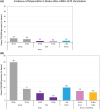COVID-19 vaccine induced myocarditis in young males: A systematic review
- PMID: 36576362
- PMCID: PMC9880674
- DOI: 10.1111/eci.13947
COVID-19 vaccine induced myocarditis in young males: A systematic review
Abstract
Background: Myocarditis is a rare but significant adverse event associated with COVID-19 vaccination, especially for men under 40. If the risk of myocarditis is not stratified by pertinent risk factors, it may be diluted for high-risk and inflated for low-risk groups. We sought to assess how the risk of myocarditis is reported in the literature.
Methods: In accordance with PRISMA standards, we reviewed primary publications in PubMed, Embase, Google Scholar and MedRxiv (through 3/2022) and included studies that estimated the incidence of myocarditis/pericarditis after receiving either the BNT162b2 (Pfizer), mRNA-1273 (Moderna) or Ad26COVS1 (Janssen) vaccine. The main outcome was the percentage of studies using 4, 3, 2, 1 or 0 stratifiers (i.e. sex, age, dose number and manufacturer) when reporting the highest risk of myocarditis. Secondary outcomes included the incidence of myocarditis in males after dose 1 and 2 of the BNT162b2 (Pfizer) or mRNA-1273 (Moderna) vaccine.
Results: The 29 included studies originated in North America, Europe, Asia, or were Worldwide. Of them, 28% (8/29) used all four stratifiers, and 45% (13/29) used 1 or 0 stratifiers. The highest incidence of myocarditis ranged from 8.1-39 cases per 100,000 persons (or doses) in studies using four stratifiers. Six studies reported an incidence greater than 15 cases per 100,000 persons (or doses) in males aged 12-24 after dose 2 of an mRNA-based vaccine.
Conclusions: Only one in four articles reporting myocarditis used four stratifiers, and men younger than 40 receiving a second dose of an mRNA vaccine are at greatest risk.
Keywords: COVID-19 vaccination; epidemiology; health policy; myocarditis.
© 2023 The Authors. European Journal of Clinical Investigation published by John Wiley & Sons Ltd on behalf of Stichting European Society for Clinical Investigation Journal Foundation.
Conflict of interest statement
All other authors have no financial nor nonfinancial conflicts of interest to report.
Figures



References
-
- Centers for Disease Control and Prevention . (n.d.). Selected Adverse Events Reported after COVID‐19 Vaccination. Centers for Disease Control and Prevention; 2022. https://www.cdc.gov/coronavirus/2019‐ncov/vaccines/safety/adverse‐events...
-
- Chua GT, Kwan MYW, Chui CSL, et al. Epidemiology of acute myocarditis/pericarditis in Hong Kong adolescents following Comirnaty vaccination. Clin Infect Dis. 2021;10:ciab989. [published online ahead of print, 2021 Nov 28]. doi: 10.1093/cid/ciab989 - DOI

